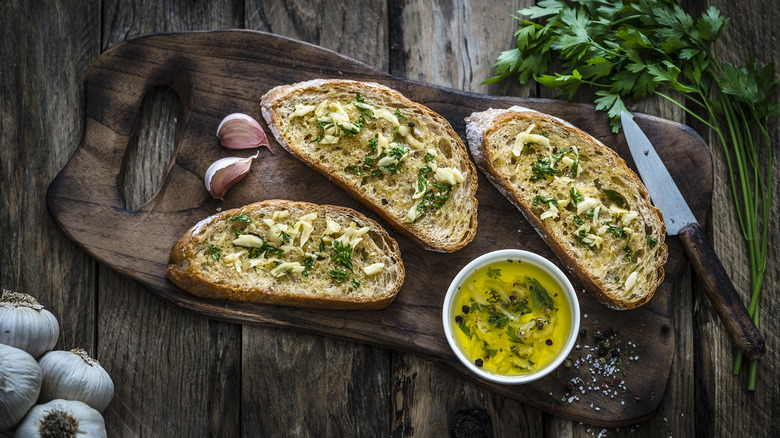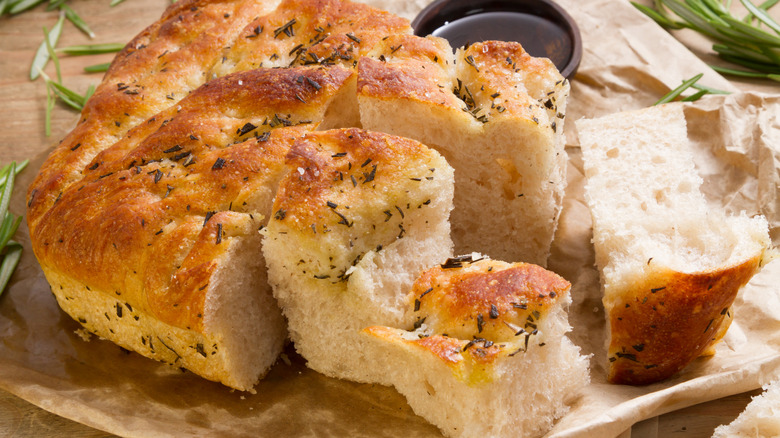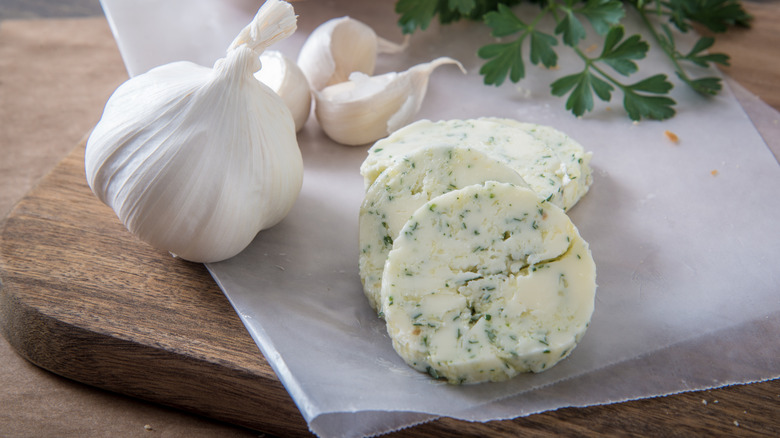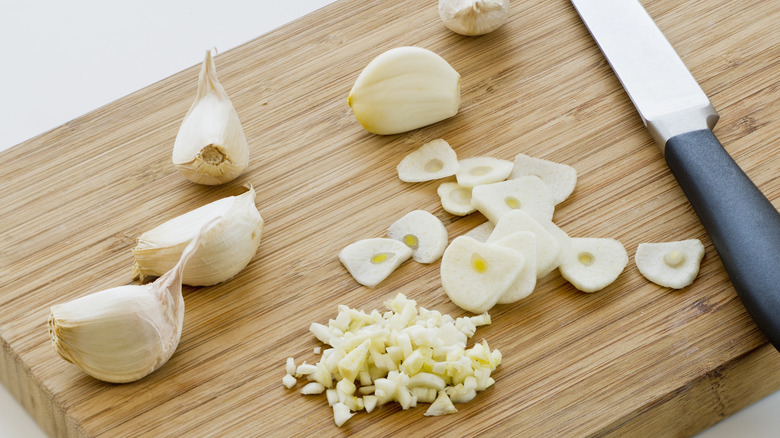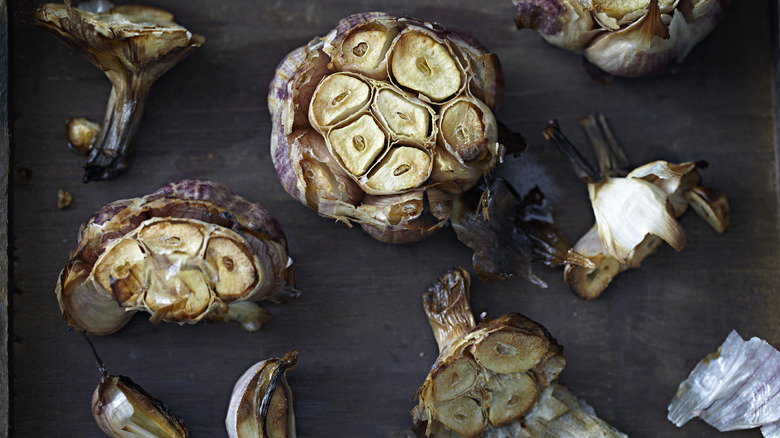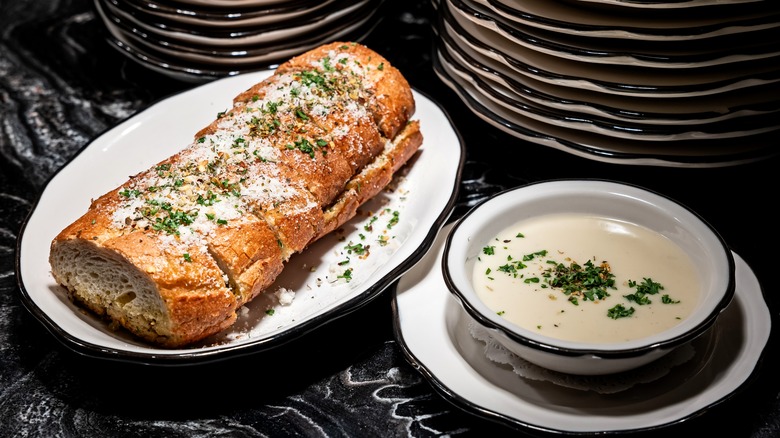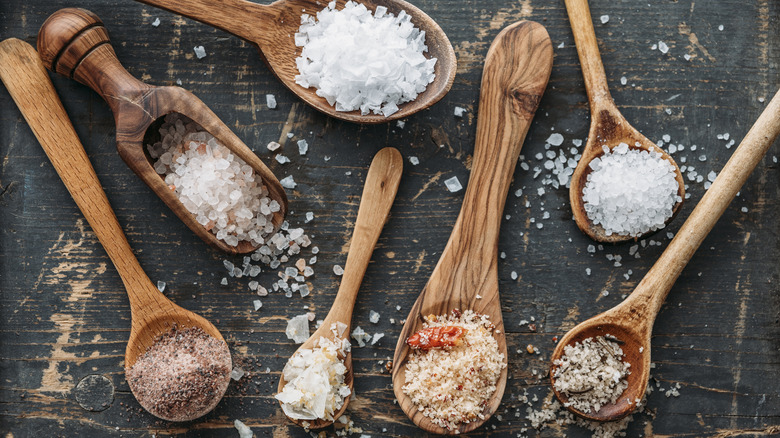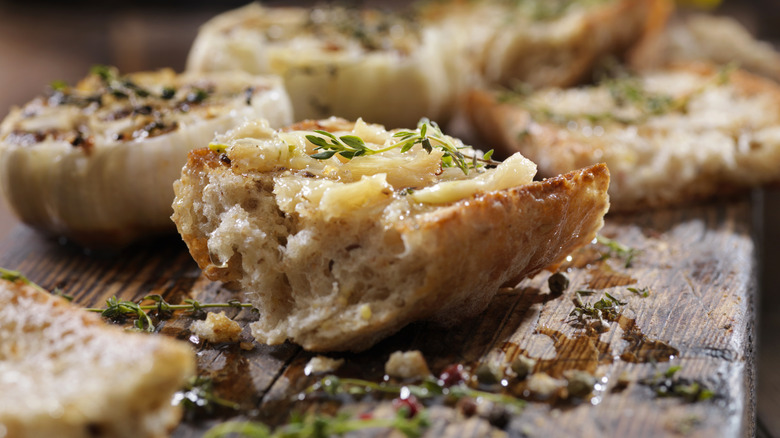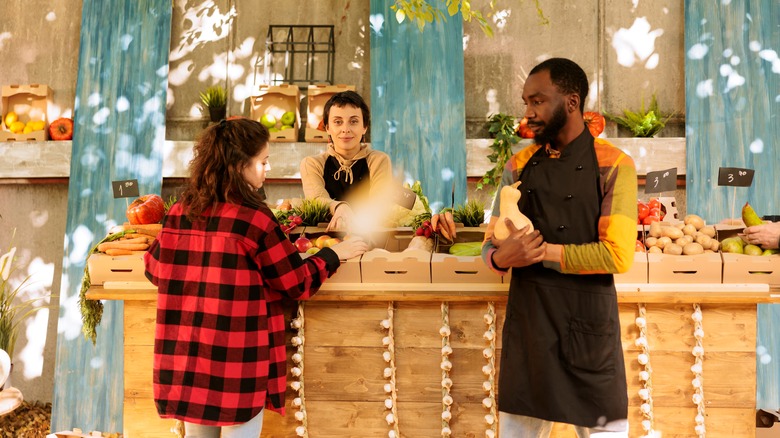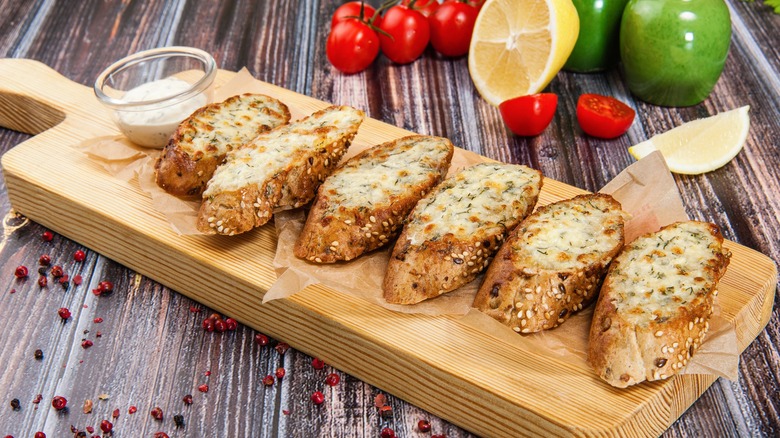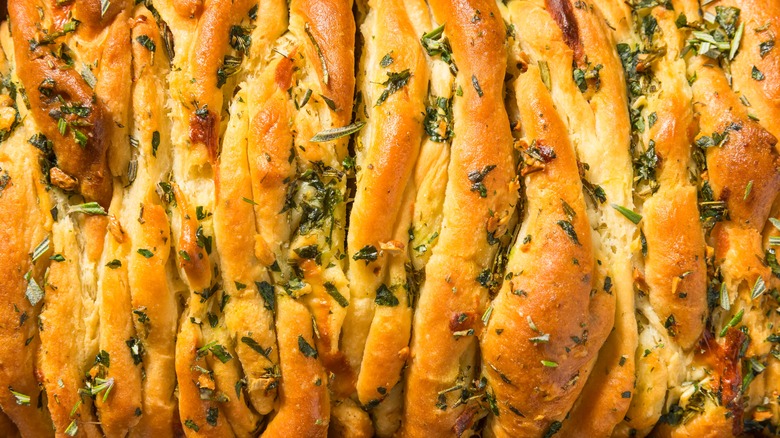Why Restaurant Garlic Bread Always Tastes Better Than Homemade
Garlic bread might seem basic. You can buy it at every grocery store and it's a staple on restaurant menus. However, it's surprisingly hard to get it right. It's easy to make garlic bread that's pretty decent, but amazing garlic bread might seem out of your reach as a home cook. And, let's not get started on grocery store garlic bread. You might be wondering how your favorite restaurant does it — and we've got answers for you.
We spoke to two chefs who serve garlic bread on their menus. Michael Friedman is a James Beard-nominated chef and owner of several Washington, D.C. restaurants, including All-Purpose, Aventino, and The Red Hen. Steve Chiappetti is executive chef of The Albert and Archive Lounge at Chicago's Hotel EMC2. Both of them have strong feelings about how to make garlic bread the right way and it shows.
If you've been puzzled over why restaurant garlic bread always tastes better than homemade or store-bought options, you're in the right place. You can upgrade grocery store garlic bread as much as you like, and you might even get tasty results, but it won't rival restaurant versions. Instead, you need to learn the secrets of chefs who make it for a living. This information might help you make better garlic bread at home. Or, it might make you change your dinner plans and go out to eat instead.
Restaurant garlic bread is made from bread baked in-house or carefully sourced
It's called garlic bread for a reason. The bread is an integral part of the recipe. Restaurant versions are often so good because the bread part is baked in-house. And, when it isn't baked by the restaurant, the chefs involved have carefully sourced it, making sure it has the right properties.
Michael Friedman explains, "We use our house-made focaccia (from our neighboring Italian café and market, Fossette Focacceria) for our garlic bread. Light, chewy, and airy, focaccia toasts really well and soaks up all the garlicky buttery goodness."
People often use baguettes to make garlic bread. And, when you buy it from the supermarket, it's usually made with this kind of bread. However, chef Steve Chiappetti tells us that baguettes aren't the way forward. "I use a more spongy bread — crusty on the outside but soft on the inside," he says. "A baguette is sometimes too dense of a bread, not really allowing the oil and butter to be soaked into the bread itself." Ciabatta is Chiappetti's favorite.
Your bread choice can make all the difference. So, if you can find some locally-made ciabatta or focaccia, you'll probably make your best-yet garlic bread. Still, even using these types of bread from the supermarket will give you better results than using a basic baguette.
Chefs often use butter and olive oil in their garlic bread
Part of what makes restaurant garlic bread so delicious is that squidgy garlicky center. But, is it oil or butter that makes it taste so great? Well, the factor you may have been missing out on is that chefs often use a combination of olive oil and butter. It makes sense. Why choose when you can have both?
"Some just use butter. Some use olive oil. But the best garlic bread uses both," says Steve Chiappetti, chef at The Albert and Archive Lounge. "This is a secret of restaurants that you won't commonly see in the home kitchen," he adds. Chiappetti explains that he first drizzles the bread with olive oil, then spreads butter across the bread before baking.
But not every restaurant uses both oil and butter. Michael Friedman of All-Purpose in Washington D.C. tells us that they only use butter. "We essentially make a compound butter with fresh garlic, roasted garlic, oregano, black pepper, and lemon zest."
If you're wondering what a compound butter is, it's effectively just butter mixed with any other ingredient. In the case of garlic bread, it's generally garlic and other seasonings. Chiappetti also mentions making a compound butter for his garlic bread. This is a great way of getting an even distribution of ingredients and it's also easy to slather onto bread.
Restaurant garlic bread is made using fresh garlic
The difference between restaurant garlic bread and what you make at home or buy from the store might be the type of garlic used. While it might seem fine to use just garlic powder or granulated garlic for convenience, garlic bread from restaurants usually includes at least some fresh garlic.
"Fresh garlic is best," Steve Chiappetti remarks. However, it's not always just fresh garlic that chefs include. "I love to use both fresh and granulated garlic when making my garlic bread," says Chiappetti. However, he recommends that you "avoid garlic powder like the plague." If you're wondering the difference between garlic granules and garlic powder, it's mainly about the consistency. Garlic powder is fine, while garlic granules are chunkier. It's easy to overdo it with the powdered stuff, which may be part of why it's not good for garlic bread.
So, you might find a blend of fresh garlic and granulated in some restaurant garlic bread. But, plenty of chefs stay away from the granulated stuff, too. Still, they may combine fresh garlic with other forms. "We use a mixture of fresh slivered garlic and roasted garlic," Michael Friedman tells us.
It's natural that chefs all have their own garlic bread recipes and preferences for various types of garlic, but if your homemade version doesn't contain any of the fresh stuff, you're doing it wrong. It may take some experimentation to figure out what you like. Just fresh or a combination of types.
Chefs may use roasted or confit garlic in their garlic bread
Some chefs use either roasted garlic or confit garlic for making garlic bread. When roasted, garlic takes on a mild, sweet flavor and a soft, spreadable consistency, making it a subtle addition. If you're wondering how to make your own, follow an easy roasted garlic recipe. It takes a bit of time in the oven, but it's a straightforward process. It can be used on its own, but a combination of sweet roasted garlic and punchy fresh garlic is delicious.
Steve Chiappetti recommends storing a jar of roasted garlic and oil in your fridge so you can use it to quickly and easily make garlic bread when you're in the mood. "When you want that garlic-infused bread, cut the bread in half and spread it with the cooked garlic and olive oil, a dash of fresh oregano or thyme and bake," he suggests. "This is a sweeter version of the typical family-style garlic bread."
According to Michael Friedman, roasted garlic confit is an alternative to classic roasted garlic — one he uses at his restaurants. "We take whole garlic cloves and slowly braise them in olive oil until caramelized," he says. "This allows the garlic's natural sweetness to come out, along with a nutty, toasted note that is as delicious as it is addictive." Friedman mixes this garlic and the fresh stuff with butter to make garlic bread.
Restaurant garlic bread often contains more garlic than homemade
If you're wondering why your homemade garlic bread lacks a certain something, it might be that you're simply using less garlic than chefs would at a restaurant. "In a restaurant setting, we likely use a bit more garlic than the average person might when making it home," Michael Friedman tells us. While Steve Chiappetti remarks that he's sure he uses "way more" garlic than a home cook.
This is a common mistake people make when cooking at home. It's easy to be scared of ingredients with bold flavors and use them sparingly. However, with something like garlic bread, you should go big or go home. Or, more accurately, go big or go to a restaurant to eat top-notch garlic bread.
You can use more garlic than you probably think. Start by following a recipe from a trusted source and if you think it needs something extra, use more garlic the next time you make it. Remember that roasted garlic is significantly milder than fresh. So, when you're using this in a recipe, you might need as many as three bulbs of garlic. That's right, bulbs not cloves.
Garlic bread from a restaurant is salted properly
Salt is another ingredient that people are often scared of. In fact, chef and cookbook author Samin Nosrat says one of the biggest mistakes people make with salt is not knowing about the types of salt available and how to use it. This can lead to under-seasoned food that needs to be salted at the table. And, garlic bread doesn't escape this fate. It's commonly under-salted and this makes the finished bread bland and boring.
We all know that food needs salt to taste good, but why? "The salt content elevates the flavor of the components of garlic bread," Michael Friedman explains. It's not just that salt makes food taste salty, it also elevates that flavor of the other elements. So, salt makes garlic more garlicky and butter more buttery. "But beware," Friedman adds. "Too much salt makes it inedible, and not enough salt makes it a rich, bland mess."
"Under seasoning is also another pitfall when it comes to making delicious garlic bread," Steve Chiappetti remarks. He recommends using "kosher salt for larger flakes and more distinct taste." That slight crunch that flakes of kosher salt or sea salt brings contrasts the center of the bread, which can be soft and slightly stodgy. Thinking about texture in this way is another part of what makes restaurant garlic bread superior to store-bought or homemade options.
Herbs and other seasonings are key in garlic bread from a restaurant
You might think garlic bread just needs garlic, oil or butter, and salt. However, the best restaurant garlic bread uses a variety of other seasonings. Expanding seasonings beyond just salt brings a greater depth of flavor. And, of course, herbs add a lot to the party, as well.
"We use Sicilian oregano in our garlic butter and finish the garlic bread with fresh parsley for a nice, herbal note," Michael Friedman tells us. Aside from oregano, Friedman seasons garlic bread with lemon zest and black pepper. The pepper brings slightly spicy notes while the lemon zest adds brightness.
"Oregano is my go-to on this dish but you can mix it up with rosemary or marjoram, too," says Steve Chiappetti. If you're wondering whether to opt for fresh or dry herbs, "fresh is always bright, brilliant, and robust," he explains. "Dry is absolutely fine as well but be careful of the amounts since an overage can give a medicinal flavor," he adds. In addition to fresh oregano, Chiappetti uses black pepper, and chili flakes to season his garlic bread.
If you want to up your game when making garlic bread at home, embrace herbs and look beyond just salt for seasoning. Chefs consider the balance of flavors and seasonings, which is part of what makes restaurant garlic bread so great.
Chefs carefully source ingredients for their garlic bread
It's not just the ingredients used in restaurant garlic bread but their overall quality. When you make garlic bread at home, you'll probably pick up whatever ingredients you can get at the supermarket. Chefs, on the other hand, are professionals who pore over ingredients and make sure they buy from the best stockists. This can make the difference between decent garlic bread and an amazing example of the dish.
"I used to think ingredients were just about recipes — give me the ingredients, follow the recipe and you have a great dish," says Steve Chiappetti. "But the real secret to cooking is to get to know your ingredients; where are they from and how are they grown?" When looking for quality ingredients, he recommends choosing seasonal products and sourcing them close to home. He looks for local farmers markets and local dairy farmers.
Michael Friedman agrees that ingredient quality is important. "Good ingredients matter. It's important to source well and talk to your purveyors about what's available," he remarks. "If you use subpar ingredients, the end result will be, well, subpar." So, for those really serious about making great garlic bread, buy the bread from a local bakery, get herbs and garlic from the farmers market, and look for butter from an independent dairy. These changes will elevate the recipe, making it incredible rather than just pretty tasty.
Restaurant garlic bread is sometimes topped with cheese
In restaurants, garlic bread may feature cheese as a topping or finishing to level it up. And, this isn't your standard cheesy garlic bread, either. It's a more elevated alternative. It may be what you're missing in pursuit of garlic bread excellence.
"When exiting the oven, I add a shred of Asiago or pecorino cheese," Steve Chiappetti tells us. And he's not the only one. Michael Friedman also adds a cheesy twist to his garlic bread. "Finishing with fresh Parmigiano-Reggiano and parsley takes it over the top," he says. Friedman also has a signature garlic bread at All-Purpose that comes with a truffle fonduta. This is a kind of Italian take on a fondue sauce, made with mascarpone and fontina cheeses.
You can opt to follow a recipe, such as this cheesy ciabatta garlic bread recipe. However, you can also use your usual favorite garlic bread recipe and add a grating of hard cheese, such as Parmigiano-Reggiano or pecorino, when it comes out of the oven.
Chefs taste as they go when making garlic bread
One thing that professional chefs do that home chefs often overlook is tasting as they cook. If you wait until your garlic bread is cooked before you try it, there's not much you can do if the balance of flavors is off. "Tasting is essential, and testing gets you to a point where you're happy with the final product," Michael Friedman says.
Now, you might be wondering how you achieve this. It's not like a stew or a sauce that you can taste during the cooking process. However, that doesn't mean you can't taste as you go. First off, you can taste some of the bread that you're using. This can help with the final balance of flavors. For instance, if it's fairly salty, you'll know to reduce the amount of salt in your recipe.
If you make a compound butter for your garlic bread, you can also taste this before you spread it on your bread to assess the seasoning. Just bear in mind that any raw garlic in the butter will mellow in the oven, so you shouldn't worry about it being sharp. Tasting as you go will give you better overall results and no surprises when you get your garlic bread out of the oven.
